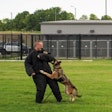Training for any agency's SWAT team is physically, mentally, and tactically challenging. Add in long and changing shift work hours, family obligations, and not enough time in the day, and your goal of joining a SWAT team appears even more difficult. The goal of this article is to assist those police officers currently on the force in achieving the fitness level of Special Weapons and Tactics (SWAT) officers.
Obtaining SWAT team membership naturally requires you to be in better shape than the average officer, in addition to having above average shooting skills. Being a team player is just as important as advanced fitness levels and shooting well. But, it is ultimately up to the individual to have the motivation to exercise before or after shift and on days off. This ability will be a determining factor in the SWAT candidate's success or failure.
This article will help you create a program that is right for you and will take into account all the testing items of your department's SWAT team screening. Whether a patrol officer or SWAT team member, being more physically fit will enable you to better focus on the task at hand instead of being unable to perform a task due to a lack of strength or endurance.
Creating Your Exercise Routine
To create one program for all law enforcement officers would be impossible. Police forces do not have the same standards of fitness and many do not even test in the same exercises or events. It is best to find out what your city, county, or state test is and prepare properly for the fitness test at least four to six months in advance.
The workout you create for your SWAT team requirements should take into consideration the make-up of the police officer's daily routine. As a police officer on the street, most of the day is spent sitting or walking while on patrol. In an instant, you sprint, jump, climb, crawl to help someone or to wrestle a person to the ground. All in a day's work, right?
This is very similar to the skills used by a football player. As in policing, on a football field, speed, strength, and quickness are needed in an instant. But you must add to your skill set the stamina and endurance of a boxer or wrestler when it really counts to successfully apprehend a suspect.
That is why the workouts you create should include high-repetition calisthenics, heavy and light weight lifting, short sprints, and longer runs or swims to complete the total package of what is needed to be the "best on the street."
SWAT Standards
Whether you attend a local, state, or federal law enforcement academy, you will be required to enter the institution by passing a physical fitness test. SWAT and Military Special Forces physical standards prove very challenging to the majority of applicants-even more so than the police academy.
SWAT team entry standards are just as varied throughout the United States as police academy standards. Depending upon the location of the department, many SWAT teams require you to endure water confidence and swimming tests in addition to running, rope climbing, pushups, dips, sit-ups, pull-ups, and obstacle courses. And there are various other tests not mentioned here that you might be required to pass. You'll have to do your homework to make sure you'll be prepared for your agency's testing.
Although there are several hundred SWAT units across the United States, this article and sample workout plan focus on job-related tasks used to test the FBI SWAT teams at their field offices across the country. There are SWAT units with easier standards and others with much more challenging standards, but you should be able to create a plan for your needs using this fitness model.
The FBI Field Office SWAT Team Performance Standards Test (PST) consists of three events:
1) The Pursuit Rescue Climb
2) The Assault Dash
3) The Tactical Obstacle Course
Each event mimics actual job-related tactics and requires speed, agility, strength, and endurance. The three testing events will be broken down into body parts required for performance and essential exercises to assist in growth for that event, so you will see what exercises will assist in preparing for such tests.
For instance, the Pursuit Rescue Climb is a weighted pull-up test in which each member wears a SWAT vest weighing 25 pounds. (The vest plus two 7-pound plates equal 25 pounds.) The muscles involved are the forearm grip muscles, biceps, back, and abdominal muscles.
Some of the exercises used to help develop these areas include:
- Pull-ups (non-weighted and weighted)
- Negative pull-ups
- Assisted pull-ups Towel pull-ups
- Pull-downs
- Bent-over rows
- Bicep curls
- Variety of abdominal exercises
- Lower back exercises
The Assault Dash is not your ordinary 40-yard sprint you may have run in high school. This one requires you to wear body armor weighing 18 pounds (an 11-pound SWAT vest plus one 7-pound plate), carry a Remington 870 shotgun, and wear a helmet. Starting in the prone position, the candidate must run 40 yards as quickly as possible.[PAGEBREAK]
Some of the exercises used to prepare for this tested event include:
- 8-Count body-builder pushup
- Squat thrusts
- Squats Lunges
- Sprints
- Variety of abdominal exercises
- Lower back exercises
The Tactical Obstacle Course is a half-mile run with three job-related tasks thrown in at the 220-yard, 440-yard, and 660-yard marks. These tasks are:
- 220-yards mark: Cone running weave (40 yards long); 9 cones spaced 5 yards apart.
- 440-yard mark: 175-pound victim drag (10-yard drag).
- 660-yard mark: Cone running weave, dropping to the prone position at each cone.
This event tests speed, endurance, and agility. Done in regular exercise clothing, the candidate will not be weighed down by the SWAT vest. The exercises to help train for this event are:
- 2- and 3-mile track workouts
- 8-count body-builders
- Bear crawls
- Squats
- Sprints
- Agility drills/box drills
- Lower back exercises
- Grip exercises (towel pull-ups)
Time to Exercise
I would be remiss in my duties as a fitness writer if I did not assist with helping police officers "fit fitness into their busy schedules." The truth is if you do not schedule a workout in your day, it will not occur. The good news is that you don't need two to three hours a day to train.
You can get a tremendous amount of activity done in as little as 30 minutes. And once you get into better shape, you can add a second 30-minute workout into your schedule if you don't have time for a solid hour of exercise.
Finding the place to fit your workouts into your day is up to you. Some people are better exercisers first thing in the morning. Some are afternoon or evening exercisers. The key is to do what you can on days you have to work a full day. Then on your days off, crank up the workout so you can fit in just about everything that your SWAT team tests.
Here are some ideas for quick 20- to 30-minute workouts.
Running How much running can you do in 20 to 30 minutes? Some people can run three to six miles in that time period. Try this one if you want to run.
4-Mile Track Work: Jog 1 mile in 7 minutes
Three sets of:
- Sprint-1⁄4-mile FAST
- Jog-1⁄4-mile
Six sets of:
- Sprint-1⁄8-mile FAST
- Jog-1⁄8-mile
Or you can mix the two types of exercise together and do what I call the Spartan run.
Spartan run:
- Run 1 mile
- 50 pushups/20 squats
- 50 crunches
- Run 1 mile
- 50 pushups/20 squats
- 75 crunches
- Run 1 mile
- 50 pushups/20 squats
- 100 crunches
Swimming How much swimming can you do in 20 to 30 minutes? Some people can swim a mile in that time. Here is a great workout if you want to mix a little PT in with your swimming.
Swim PT:
- Repeat 5-10 times
- Swim 100 yards
- Pushups-10-20
- Abs-20-30
Treading water for 20 or more minutes is a standard test among some SWAT units. Try treading while not using your hands for a real water workout. As you can see, you can do quite a bit in as little as 20 to 30 minutes.
I cannot stress how important fitness is to your job performance and life. In fact, your fitness level may be the factor that saves your life or your partner's life one day.
In physically demanding professions as a police officer or SWAT team member, being able to run fast or climb stairs quickly after sitting in a car for hours can take its toll on you. This is why proper training and stretching should be a daily occurrence, even if you are not going to the gym that day.
WARNING
These workouts are a little advanced and you should consult your doctor before starting an exercise program, especially if you have not exercised rigorously in several years.
Stretching Program and Injury Prevention
Any routine should incorporate DAILY flexibility training. In fact, you can stretch nearly all day long for just a few minutes throughout the day. Flexibility is the key to speed and injury prevention. If you cannot touch your toes or twist your torso 90 degrees, the lack of upper body and lower body flexibility will come back to haunt you one day. Usually, lack of flexibility will manifest itself as an injury or the lack of agility and speed to catch a running criminal.
Stew Smith is a Naval Academy graduate and former Navy SEAL who now works as a fitness trainer and freelance writer. He specializes in preparing clients for law enforcement and military physical fitness tests. He can be reached at StewSmith.com.
















